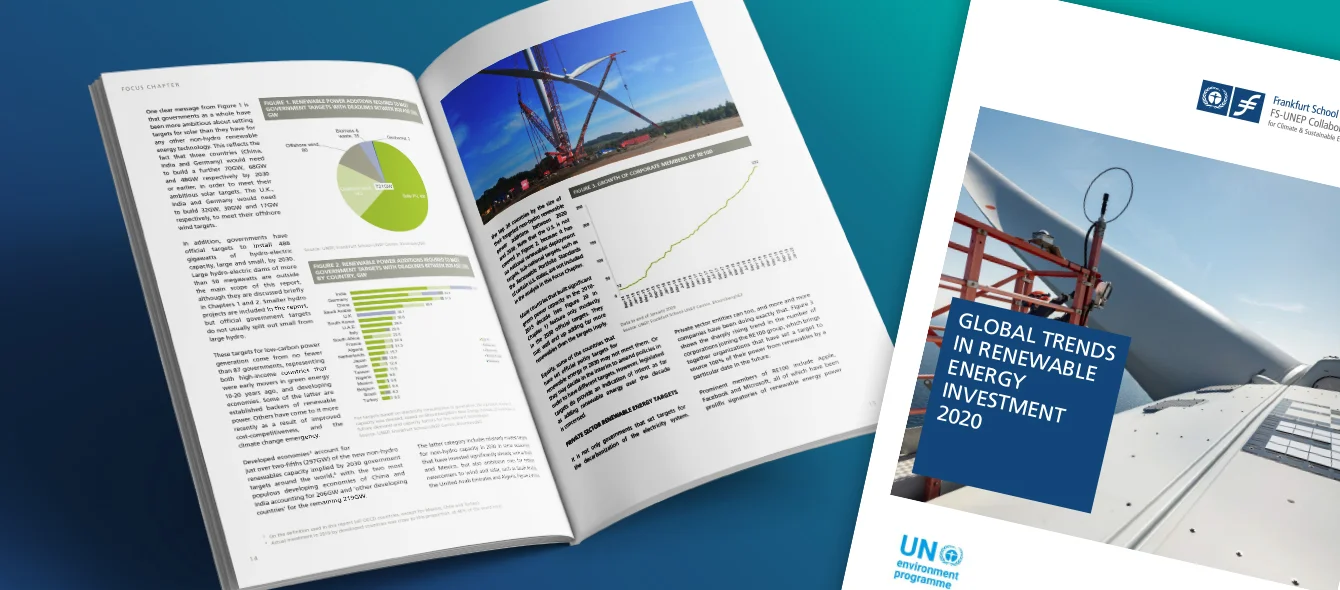Last year, more wind turbines and solar panels were installed than ever before. This is a statistic that can be gleaned from the Global Trends in Renewable Energy Investment Report 2020 which just came off the press. The report further states that 184 gigawatts (GW) in renewable generation capacity (excluding large-scale hydroelectric power stations) were financed last year – 20 GW more than in 2018. According to the report by the UNEP-Collaboration Centre of the Frankfurt School of Finance & Management and the consultancy BloombergNEF, investment totalled some 282.2 billion US dollars.
What comes as a surprise, however, is that investment was just one percent up year on year, despite the significant increase in expansion. This is because plant costs dropped dramatically, continuing a years-long trend: Over the last ten years, the costs of PV units have declined by 83 percent, while those of wind turbines have roughly been cut in half.
Solar sector records biggest gain
Consequently, solar’s 118 GW jump represented the strongest increase, although spending on the sector was down three percent to 131.1 billion dollars. By contrast, there was a slight rise in investment in wind energy expansion. At 138 billion dollars, it bested the figure for solar power (131 billion) for the first time since 2010. This capital expenditure was good for 61 GW of additional installed capacity.
Net power generating capacity added in 2019 by main technology
Source: UNEPThe significant expansion was reflected in the energy mix. Last year, the share of power production accounted for by renewables was 13.4 percent, up one percentage point on 2018.
China and USA boast highest investment
According to the report, as in earlier years, over half of the investment in renewable energy was made in emerging and developing countries. This includes the largest financing of a solar project to date: Al Maktoum in the United Arab Emirates attracted an investment of 4.3 billion dollars. Taiwan also registered record spending, totalling 8,8 billion dollars for three onshore wind projects.
Conversely, investment in China and India decreased. Nevertheless, recording 83.4 billion dollars in capital expenditure, China remained the world leader by a clear margin, followed by the USA. The report shows the same ranking for 2010 to 2019. Over a ten-year horizon, Germany is the top-ranked European country, occupying fourth sport. However, investment in Germany was down nearly one-third last year. A total of 4.3 billion dollars were spent, with 3.4 going to new PV systems and wind turbines accounting for just one billion. Onshore wind’s weakness clearly leaves its marks here (perhaps insert a link here?). More money was invested in Spain (8.4 billion) and the Netherlands (5.5 billion). Last year, these two countries were Europe’s front runners, each posting a 25 percent rise in investment over 2018.
Investment in renewable energy capacity by region in 2019
Source: UNEPExpansion will lose momentum until 2030
The study has expenditure on renewables expansion shrinking considerably in the next few years: 87 governments recently agreed to invest a combined one trillion dollars to enlarge capacity by 826 GW through to 2030. By comparison, a whopping 1,213 GW were built for 2.7 trillion in the past decade.
Therefore, the study’s authors make a sombre forecast with respect to the achievement of the climate goals. The cost of generating electricity from renewables may have dropped significantly in recent years, but the goal is not ambitious enough to hit the climate targets and limit global warming to less than two degrees centigrade. The authors are thus convinced that capacity must be expanded much more in order to combat climate change.
Photo credit: © UNEP
